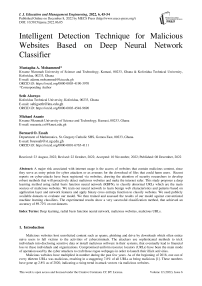Intelligent Detection Technique for Malicious Websites Based on Deep Neural Network Classifier
Автор: Mustapha A. Mohammed, Seth Alornyo, Michael Asante, Bernard O. Essah
Журнал: International Journal of Education and Management Engineering @ijeme
Статья в выпуске: 6 vol.12, 2022 года.
Бесплатный доступ
A major risk associated with internet usage is the access of websites that contain malicious content, since they serve as entry points for cyber attackers or as avenues for the download of files that could harm users. Recent reports on cyber-attacks have been registered via websites, drawing the attention of security researchers to develop robust methods that will proactively detect malicious websites and make the internet safer. This study proposes a deep learning method using radial basis function neural network (RBFN), to classify abnormal URLs which are the main sources of malicious websites. We train our neural network to learn benign web characteristics and patterns based on application layer and network features and apply binary cross entropy function to classify websites. We used publicly available datasets to evaluate our model. We then trained and assessed the results of our model against conventional machine learning classifiers. The experimental results show a very successful classification method, that achieved an accuracy of 89.72% on our datasets.
Deep learning, radial basis function neural network, malicious websites, malicious URLs
Короткий адрес: https://sciup.org/15018580
IDR: 15018580 | DOI: 10.5815/ijeme.2022.06.05
Список литературы Intelligent Detection Technique for Malicious Websites Based on Deep Neural Network Classifier
- D. Sahoo, C. Liu, and S. C. Hoi, “Malicious url detection using machine learning: A survey,” arXiv preprint arXiv:1701.07179, 2017.
- C. Do Xuan, H. D. Nguyen, and V. N. Tisenko, “Malicious url detection based on machine learning,” International Journal of Advanced Computer Science and Applications, vol. 11, no. 1, 2020.
- A. D. Gabriel, D. T. Gavrilut, B. I. Alexandru, and P. A. Stefan, “Detecting malicious urls: A semi-supervised machine learning sys Use the "Insert Citation" button to add citations to this document. tem approach,” in 2016 18th International Symposium on Symbolic and Numeric Algorithms for Scientific Computing (SYNASC), pp. 233–239, IEEE, 2016.
- F. O. Catak, K. Sahinbas, and V. Dörtkarde¸s, “Malicious url detection using machine learning,” in Artificial intelligence paradigms for smart cyber-physical systems, pp. 160–180, IGI Global, 2021.
- S. C. Hoi, D. Sahoo, J. Lu, and P. Zhao, “Online learning: A comprehensive survey,” Neurocomputing, vol. 459, pp. 249–289, 2021.
- C. Seifert, I. Welch, and P. Komisarczuk, “Identification of malicious web pages with static heuristics,” in 2008 Australasian Telecommunication Networks and Applications Conference, pp. 91–96, IEEE, 2008.
- S. Sheng, B. Wardman, G. Warner, L. Cranor, J. Hong, and C. Zhang, “An empirical analysis of phishing blacklists,” 2009.
- S. Sinha, M. Bailey, and F. Jahanian, “Shades of grey: On the effectiveness of reputation-based “blacklists”,” in 2008 3rd International Conference on Malicious and Unwanted Software (MALWARE), pp. 57–64, IEEE, 2008.
- D. Wang, S. B. Navathe, L. Liu, D. Irani, A. Tamersoy, and C. Pu, “Click traffic analysis of short url spam on twitter,” in 9th IEEE International Conference on Collaborative Computing: Networking, Applications and Worksharing, pp. 250–259, IEEE, 2013.
- L. Xu, Z. Zhan, S. Xu, and K. Ye, “Cross-layer detection of malicious websites,” in Proceedings of the third ACM conference on Data and application security and privacy, pp. 141–152, 2013.
- E. Benavides, W. Fuertes, S. Sanchez, and M. Sanchez, “Classification of phishing attack solutions by employing deep learning techniques: A systematic literature review,” Developments and advances in defense and security, pp. 51–64, 2020.
- H. Le, Q. Pham, D. Sahoo, and S. C. Hoi, “Urlnet: Learning a url representation with deep learning for malicious url detection,” arXiv preprint arXiv:1802.03162, 2018.
- W. Yang, W. Zuo, and B. Cui, “Detecting malicious urls via a keyword-based convolutional gated-recurrent-unit neural network,” IEEE Access, vol. 7, pp. 29891–29900, 2019.
- J. Saxe and K. Berlin, “expose: A character-level convolutional neural network with embeddings for detecting malicious urls, file paths and registry keys,” arXiv preprint arXiv:1702.08568, 2017.
- J. Ma, L. K. Saul, S. Savage, and G. M. Voelker, “Identifying suspicious urls: an application of large-scale online learning,” in Proceedings of the 26th annual international conference on machine learning, pp. 681–688, 2009.
- B. Eshete, A. Villafiorita, and K. Weldemariam, “Binspect: Holistic analysis and detection of malicious web pages,” in International conference on security and privacy in communication systems, pp. 149–166, Springer, 2012.
- S. Purkait, “Phishing counter measures and their effectiveness–literature review,” Information Management & Computer Security, 2012.
- S. C. Hoi, J. Wang, and P. Zhao, “Libol: A library for online learning algorithms,” Journal of Machine Learning Research, vol. 15, no. 1, p. 495, 2014.
- Y. Tao, Suspicious URL and device detection by log mining. PhD thesis, Applied Sciences: School of Computing Science, 2014.
- G. Canfora, E. Medvet, F. Mercaldo, and C. A. Visaggio, “Detection of malicious web pages using system calls sequences,” in International Conference on Availability, Reliability, and Security, pp. 226–238, Springer, 2014.
- G. Hinton, L. Deng, D. Yu, G. E. Dahl, A.-r. Mohamed, N. Jaitly, A. Senior, V. Vanhoucke, P. Nguyen, T. N. Sainath, et al., “Deep neural networks for acoustic modeling in speech recognition: The shared views of four research groups,” IEEE Signal processing magazine, vol. 29, no. 6, pp. 82–97, 2012.
- D. Svozil, V. Kvasnicka, and J. Pospichal, “Introduction to multi-layer feed-forward neural networks,” Chemometrics and intelligent laboratory systems, vol. 39, no. 1, pp. 43–62, 1997.
- M. T. Musavi, W. Ahmed, K. H. Chan, K. B. Faris, and D. M. Hummels, “On the training of radial basis function classifiers,” Neural networks, vol. 5, no. 4, pp. 595–603, 199
- Y. Wang, Y. Li, Y. Song, and X. Rong, “The influence of the activation function in a convolution neural network model of facial expression recognition,” Appl. Sci., vol. 10, no. 5, p. 1897, 2020.


